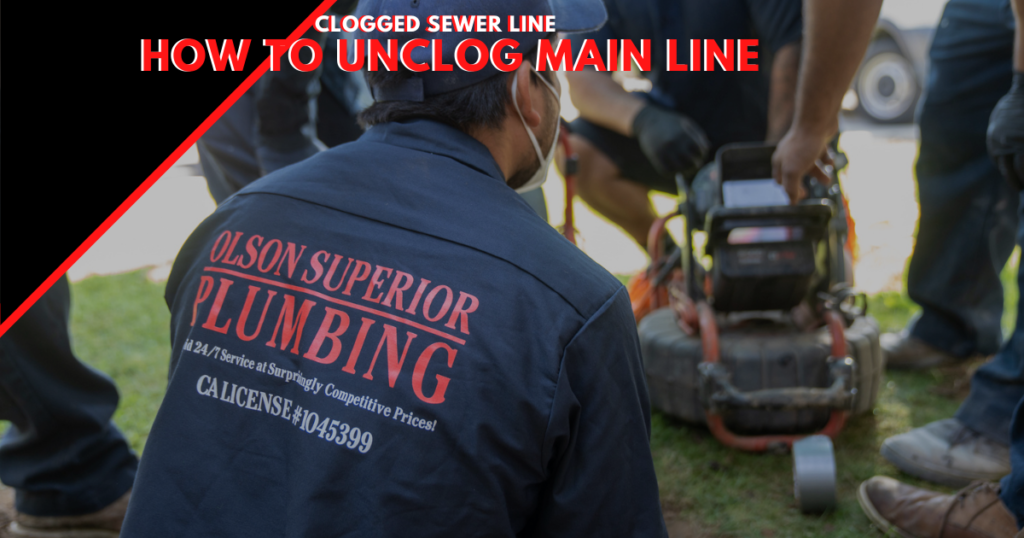
Wondering how to fix clogged sewer lines? A sewer line is extremely important since it helps keep the urban environment clean by transporting wastewater to the nearest treatment plant. With the main sewer line clogged, the drains will slow down or stop completely.
Broken pipes and debris can accumulate in the sewer system and cause clogging. Even if you flush your drains regularly, blockages will eventually find their way into your drains.
8 Signs of a Sewer Line Clog
Wastewater is a health hazard that should be addressed by a professional. Your sewer line may be clogged if a foul odor comes from the sink, toilet, tub, or shower. That foul odor is sewage that drains poorly as a result of clogs.
Blockages can cause household drains to stop working since they are connected to the sewer system. The water levels in the toilet fluctuate when the drains don’t work properly or the toilet won’t flush. Drains that are connected can gurgle once you flush the toilet.
When a drain line breaks, the cost of repair can escalate significantly. The price will even go up if the main sewer line is difficult to access. If tree roots have clogged the sewer system or concrete slabs need to be removed, be prepared to spend over $150 per hour for excavations and repairs.
- Frequent Clogs – If you notice that toilets, kitchen, and bathroom sinks, and bathtubs or showers in your home frequently fail to drain without the use of a plunger or a chemical drain cleaner, you may have a main sewer line clog. Don’t ignore this problem – especially if you have to use a plunger or chemical drain cleaner each time you flush or use the sink.
- Slow Drains – A clear sign of sewer blockage is when you notice that several of your drains have slowed down at the same time. If you suspect a drain clog check all your low-lying fixtures. These include the toilet, the bathtub, and the bathroom. If most of them are slow or not draining at all, then you have a problem.
- Bad Odors – When your main sewer drain and lines are blocked, wastewater comes back into your sinks, toilets, and bathtubs. Although you may not see the water immediately after the blockage starts, you will notice a bad smell. That is a sign that dirty water is seeping back into the drain pipes or not draining at all.
- Multiple Fixtures Involved – Flushing the toilet only to have your bathtub fill with water, or running your washing machine and your toilet overflows probably means you have a clog somewhere.
- Unusual Noises – Does your toilet make a gurgling sound after each flush? When you run the water in the sink or after you turn off the shower, do you hear creaking sounds or other strange noises coming from the walls or through the floors? If so, you may have a clog in one of the sewer pipes.
- Rising And Falling Water Level In The Toilet – You probably have a problem with your main sewer drain lines if the water in your toilet rises and falls for no reason. Check whether the water level is affected by draining your bathtub or kitchen sink. If that is happening, you need to have your sewer lines inspected.
- Water Flowing Out Of The Cleanout – The cleanout is the upright pipe that plumbers use to unblock sewer lines. If you notice water flowing out of it, you have a sewer drain clog. Apart from being unsanitary, the water can make your yard smell very bad.
- Exterior Issues – Inspect the exterior of your home for water puddles (especially if it hasn’t rained in a while), bad odors, yellow and brown patches on your lawn, or exposed tree roots that seem too close to your home. These issues typically indicate a main sewer line clog.
There are a variety of reasons why sewer lines get blocked. Unclogging them yourself can make the problem worse, so it is always advisable to talk to a professional plumbing contractor. He or she can inspect the system, clean it, and tell you what caused the clog. Here are some possible causes of a sewer clog.
- Severe Pipe Damage – When the sewer pipe is broken or damaged, the sewer line will not drain properly. Sewer pipes can rupture when there is increased traffic above ground or the use of heavy construction equipment. Bear in mind that when metal pipes break due to corrosion, they do not drain properly.
- Sagging Sewer Lines – Soil changes can cause your sewer line to sag. When this happens, the section that has sunk collects paper and waste resulting in a blockage.
- Root Infiltration – If you have older main sewer drain and lines made of porous materials like clay, trees, and shrubs roots, latch onto them. As they grow and the roots get bigger, they can break the sewer pipe and cause a clog.
- Flushing Debris Down The Toilet – There are several things that you cannot flush down the toilet. When you flush facial tissues, eggshells, coffee grounds, toilet scrub pads, and tampons down the toilet, it will clog your sewer line.
Ways to Prevent Future Sewer Line Clogs
Prevent future clogs by maintaining clean sewer lines. Avoid flushing feminine hygiene products, facial cleansing cloths, thick paper towels or toilet paper, and other items not intended for flushing down the toilet.
Consider removing older trees in close proximity to your home to prevent tree roots from damaging sewer lines. Tree roots can also cause main sewer line clogs by infiltrating sewer lines. Tree roots can cause toilet paper and solid waste to build up and cause clogs.
- Use Enzyme Cleaners Monthly – To prevent your sewer lines from blocking, clean them once a month with an enzyme cleaner. These do not have harsh chemicals and are safe for you and your family. That noted, make sure that you have your sewer lines inspected by a professional plumber regularly.
- Keep Plants From The Sewer Lines – Plants’ roots can affect your sewer line, so do not plant trees, flowers, or shrubs. These plants make maintenance difficult and also can damage the pipes.
- Use the wastebasket – The only thing that should be flushed down the toilet is human waste and water. Hygiene products such as sanitary pads and tampons can severely clog your sewer line.
- Replace Old Clay Pipes – If you live in an older home with lead or clay sewer pipes, consider replacing them. It will protect you from a sewer drain clog. The right plumber can quickly replace your sewer pipes, and ensure that your system is working.
Ten Ways to Unclog A Sewer Line
With the main sewer line clogged, water will start pooling around your feet in the shower. If the main sewer line is broken, it will be expensive to resolve since you will have to involve a professional plumber.
A professional plumber has access to a few tools that can safely remove sewer clogs without damaging the main sewer drain and sewer line. Mini sewer line inspection cameras help plumber diagnose the issue, while augers (drain snakes), high-power water jets, and professional-strength drain cleaners help plumbers break up or dissolve the clog.
And while you may be able to dissolve small clogs using store-bought chemical drain cleaners, you will find that major clogs require the attention of a professional plumber who can inspect all of the sewer pipes to catch every clog (yes, there may be more than one!).
There are generally three methods for unclogging a blocked sewer line. You can use the mechanical drain cleaning method, hydraulic drain cleaning method, or the chemical drain cleaning method. The aim of cleaning a sewer line is to remove non-biodegradable debris, sludge buildup, or grease from a sewer pipe. Cleaning is necessary when you have a clogged sewer pipe and during maintenance. For help with drain cleaning services, be sure to give us a call.
- Hydraulic sewer cleaning methods involve the use of pressurized water to break down and push out the clogs. Plumbers use specialized nozzles for different types of clogs.
- Mechanical sewer cleaning methods involve rodding, bucket machines and the use of capsules called pigs. These scrape or push out debris to clean the sewer clog. Bucket machines are excellent for severe clogs in large sewer pipes.
- Chemical sewer cleaning methods involve the use of chemicals to remove a blockage in pipes. They are, however, used cautiously, as chemicals may damage plants, animals, and the surrounding soils. Biological products that contain enzymes and microorganisms can also be used to clean some sewer systems.
You can also unblock your mainline yourself with an array of conventional methods. Here are ten simple yet effective ways to unclog your main sewer line.
1. The Bent Wire Hanger
Straighten a conventional wire hanger as best as you can and create a hook on one end. Push that end into the drain cover and start pulling out any items that could be causing the blockage.
Be careful and avoid pushing the gunk further down the drain. Once you get everything out, use hot water to clean the clogged sewer line.
2. Vinegar and Baking Soda
Baking Soda is a great cleaning agent since it’s a mild alkali that can dissolve dirt and grease easily. Vinegar deodorizes the drain line by neutralizing the acidic odor molecules. Mix 1/3 of a cup of vinegar with 1/3 of a cup of baking soda and pour the fizzy mixture into the clogged sewer drain immediately.
If you don’t know how to unclog the main sewer line, take advantage of vinegar to eliminate the grime, grease, and hair in the pipe. Flush the pipe with hot water after one hour.
3. The Wet and Dry Vacuum
A wet and dry vacuum is a great tool when it comes to unblocking a clogged sewer line. After covering the vent to avoid a mess, you need to create a tight seal over the drain line.
Once you adjust the vacuum settings to Liquids, it will have enough power to draw the contents from up the pipe and into the bag. If it doesn’t work, try unclogging it with a hanger first.
4. Boiling Water
Use an electric kettle to boil as much water as possible. Pour the water into the drain intermittently and allow it to percolate slowly. The hot water will get rid of the grease and grime that holds on to other debris to cause blockages.
5. Caustic Soda
Since caustic soda can cause severe chemical burns, start by protecting yourself with rubber gloves and goggles. Add 3 cups of caustic soda to 15 liters of water in a mop or bucket.
The mixture will start to fizz once you stir it well. Pour it into the drain lines and leave it for 30 minutes. Clear the drain by flushing it with boiling water.
6. Cleaning the Pipe
The flex pipe underneath the sink can clog as a result of dirt and grease. If you are going to loosen the pipe, you need to place a bucket underneath the sink to trap the foul water that will spill. Loosen the nuts with a wrench and remove them by hand.
Empty the contents of the U-shaped pipe into the bucket. Use a toothbrush to fish out any debris that remains in the pipe. Flush the pipe with hot water and tighten it once again.
7. The Drain Snake
A drain snake is a flexible and slender auger that dislodges clogs in drains in your home. The plumber’s snake comes in handy when working on difficult clogs that a plunger cannot unblock.
Push one end of the snake into the blocked drain and turn the handle. Keep pushing it until you feel some resistance. Once you rotate it against the blockage, it will get the debris out.
8. Salt and Baking Soda
When salt and baking soda mix, they undergo a chemical reaction that can unblock any drain. Once you mix salt with baking soda in a ratio of 1:2, it creates the ideal cleaning agent for your drain. Pour the mixture into the drain and let it sit for a few hours. Then, rinse the drain lines with boiling water.
9. Dish Detergent
A clogged drain can be a nightmare, and you need to know what to do before you call a plumber. A dish detergent can be used in combination with mechanical methods to unclog the drain.
Pour a quarter cup of the dish detergent into the toilet bowl and add some boiled water. The dish soap will act as a lubricant while the boiled water will dissolve the dirt. Add more hot water and use a plunger to unblock it.
10. Baking Soda, Vinegar, and Water Pressure
If the bath drain is blocked, you can unclog a drain pipe with a mixture of baking soda and vinegar. You also need a plunger and a drain snake depending on the nature of the clog. Mix baking soda and vinegar in the ratio of 1:2 and add the mixture in 60 gallons of water.
Use the plunger or drain snake as you pour the water into the drain. If you are wondering how to unclog the main sewer line, the pressure of the water will dislodge the debris easily.
Hire A Professional Plumber to Unclog the Line
If the home remedies do not work, it means that the blockage is not within your reach since it’s coming from the municipal sewer drain system. With the main sewer line clogged, you need a professional plumber to snake or hydro-jet the pipe that connects drains in your home to the municipal sewer line. Hydro jetting is a complex process that entails using high-pressure jets through the drain pipes to break up blockages and get rid of all debris. Call our team for a sewer line camera inspection to help locate and clear the clog and repair your sewer line. Also, call us for other plumbing services you may need.
If you suspect that you have a clogged sewer line in your home or business, contact our Rapid Response Team right away. We will find the sewer drain clogged and remove it before any further damage occurs. In some cases, we may have to repair the sewer line or replace it. Serving all of Orange County, CA
If you have any questions, call our 24/7 Rapid Response Team at 949-328-6002 or email us at 247@OlsonSuperior.com – If you want more information online, please visit us @https://www.OlsonSuperior.com
For industry insights, announcements, and tips make sure to follow our blog at: olsonsuperior.com/blog

